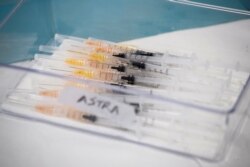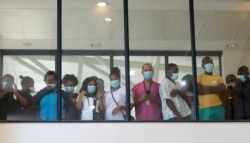Hours after U.S. federal health officials urged a pause in the use of Johnson & Johnson’s COVID-19 vaccine after it was linked to a rare but dangerous blood clot, the U.S. pharmaceutical giant announced Tuesday it was delaying rollout of the single-dose vaccine in Europe.
“We have been working closely with medical experts and health authorities, and we strongly support the open communication of this information to healthcare professionals and the public,” the company said in a written statement.
The delay strikes a major blow to Europe’s already sluggish vaccination efforts, which has been plagued by logistical problems and a shortage of vaccines. The continent’s vaccination campaign has also been hindered by the troubled rollout of the vaccine developed by British-Swedish drugmaker AstraZeneca and the University of Oxford, which has also been linked to cases of rare blood clots.
The U.S. Centers for Disease Control and Prevention (CDC) and the Food and Drug Administration (FDA) said six women between 18 and 48 years of age who had received the Johnson & Johnson vaccine developed blood clotting known as cerebral venous sinus thrombosis (CVST) within six to 13 days after being inoculated. One of the women died, while another has been hospitalized in critical condition.
Dr. Jane Woodcock, the acting commissioner of the F.D.A., told reporters Tuesday during a joint virtual briefing the pause is expected to last only “a matter of days” as both agencies investigate the matter. The CDC is holding an emergency meeting of its Advisory Committee on Immunization Practices on Wednesday to review the cases.
CDC Principal Deputy Director Anne Schuchat said people who received the vaccine more than two weeks ago have very little to fear. Those who received the vaccine within the last week or so who develop symptoms such as severe headache, abdominal or leg pain, or shortness of breath, should contact their health care provider.
They note the six cases occurred out of more than 6.8 million doses of the vaccine administered.
South Africa also followed suit Tuesday by suspending use of Johnson & Johnson COVID-19 vaccine.
Both the Johnson & Johnson and AstraZeneca vaccines were developed using so-called adenoviruses to carry DNA into human cells that generates the body’s immune system to ward off the coronavirus.
Better news on the COVID-19 vaccine front came Tuesday from Moderna. The U.S.-based pharmaceutical company said data from its late-stage clinical trials shows its two-dose vaccine is more than 90% effective against a coronavirus infection, and 95% effective against severe disease up to six months after the second dose. Moderna is currently testing its vaccine among young people between 12 to 17 years of age.
A new study conducted by U.S.-based health care provider Kaiser Permanente found that a lack of physical activity poses a greater risk of severe COVID-19 infection and death. The study, published Tuesday in the British Journal of Sports Medicine, covered nearly 50,000 people in the United States who had been diagnosed with the coronavirus. The researchers say those physically inactive for at least two years before the pandemic were twice as likely to be hospitalized as those who engaged in regular exercise.
Scientists say the previous risk factors for severe COVID-19 infection includes advanced age, being male and having such pre-existing conditions such as diabetes, obesity or cardiovascular disease.










